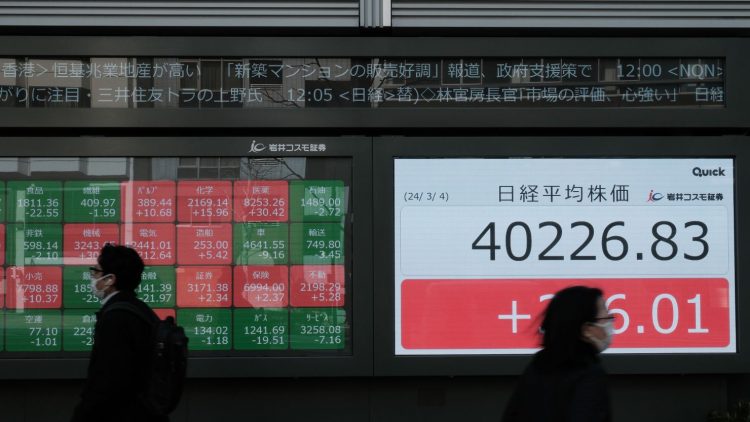Introduction: Japan’s Economic Crossroads and the Nikkei 225’s Tipping Point
As Japan stands at a crossroads, grappling with economic stagnation, demographic decline, and persistent deflation, its stock market—specifically the Nikkei 225—has become a focal point for investors. The index, representing 225 major Japanese corporations, reflects the underlying economic health of the nation and is heavily influenced by global market forces.
Today, the Nikkei 225 finds itself navigating turbulent waters as Japan faces both opportunities and risks. The question remains: Is the Nikkei 225 heading into a “stall trap” where market momentum falters under external pressures, or are we witnessing the early signs of a “liquidity siphon,” where capital flows into Japan due to favorable global economic conditions and domestic reforms?
This article explores these two opposing scenarios, providing a deep dive into the factors that could either trap investors in a downward cycle or unlock new opportunities in the Japanese market.
1. The Nikkei 225 and Its Historical Significance
The Nikkei 225 has long served as the benchmark for Japan’s stock market, providing insight into its broader economic health. The index includes large companies like Toyota, Sony, Mitsubishi, and Honda—companies that have been central to Japan’s status as an industrial powerhouse. However, Japan’s economic trajectory over the last few decades tells a different story, marked by stagnation and demographic decline.
The “Lost Decade” of the 1990s, following the bursting of Japan’s asset bubble, set the stage for a prolonged period of low growth, low inflation, and low interest rates. In recent years, Japan has attempted to revive its economy with a series of aggressive monetary policies, spearheaded by the Bank of Japan (BoJ), and structural reforms under Prime Minister Shinzo Abe’s “Abenomics.” Despite these efforts, Japan’s demographic challenges—an aging population and a shrinking workforce—continue to drag on its long-term growth prospects.
In this environment, the Nikkei 225 has shown intermittent signs of recovery but remains vulnerable to shifts in global economic sentiment. Today, investors must decide whether the current market conditions are signaling an impending “stall trap” or a “liquidity siphon” opportunity.
2. The “Stall Trap” Scenario: Risks of Overconfidence and Economic Fragility
A “stall trap” refers to a situation where a market or asset class, despite initial growth, loses momentum due to underlying economic vulnerabilities. For the Nikkei 225, several factors suggest the possibility of this scenario.
A. Global Economic Slowdown:
Japan’s economic fortunes are closely tied to global demand, especially for its export-driven industries. If global growth slows—whether due to trade disruptions, geopolitical instability, or tightening monetary policies in major economies like the U.S. and Europe—Japan could face a sharp decline in demand for its goods and services. This would likely hit the Nikkei 225 hard, particularly as companies like Toyota and Sony are highly exposed to global economic cycles.
For example, a slowdown in China, Japan’s largest trading partner, could lead to a decrease in demand for Japanese machinery and electronics. Similarly, higher interest rates in the U.S. could lead to a stronger yen, which would hurt the profitability of Japan’s exporters by making their goods more expensive abroad.
B. Demographic Challenges:
Japan’s aging population remains one of its most significant economic challenges. With a rapidly shrinking workforce, there is a growing burden on Japan’s social welfare systems, and a lack of younger workers is stifling domestic consumption and innovation. Additionally, Japan has a relatively low immigration rate, which limits its ability to offset these demographic shifts through labor market expansion.
The BoJ’s policy of negative interest rates, while intended to stimulate spending and investment, has had limited success in addressing these structural issues. Without a shift in Japan’s demographic trajectory, the Nikkei 225 could face long-term headwinds that prevent it from sustaining robust growth, ultimately leading to a stall trap scenario.
C. Overvaluation Risk:
The recent rally in the Nikkei 225, following years of stagnation, has led some analysts to question whether the index is overvalued. While Japan’s corporate earnings have improved, this improvement may be overstated due to external factors like global monetary policy and currency movements. If investor sentiment shifts, or if economic data fails to meet expectations, the Nikkei 225 could suffer from a sharp correction, as seen in previous market cycles.
If Japanese companies are unable to deliver consistent earnings growth, or if global liquidity begins to tighten, the Nikkei 225 could quickly falter, leading to a significant market downturn.
3. The “Liquidity Siphon” Scenario: Japan as a Beneficiary of Global Capital Flows
On the other hand, the Nikkei 225 could be poised to benefit from the “liquidity siphon” effect, where global capital flows into Japan due to favorable economic conditions, both domestically and globally. This would occur if several factors align to make Japan an attractive destination for investment.
A. Structural Reforms and Corporate Governance Improvements:
In recent years, Japan has taken significant steps to improve corporate governance and enhance shareholder returns. The introduction of Japan’s “Corporate Governance Code” has encouraged companies to be more transparent, reduce cross-shareholdings, and increase dividends. These measures are making Japan’s corporate sector more attractive to both domestic and foreign investors, particularly those looking for stable, long-term returns in a low-interest-rate environment.
The increased focus on shareholder-friendly practices has been well-received by global investors, especially institutional investors who are seeking higher returns than what is available in other low-yield markets. If these reforms continue to take hold, they could provide a catalyst for further growth in Japan’s equity market.
B. Global Low-Interest Rates and Capital Flows:
With global interest rates at historically low levels, investors are seeking higher returns outside of traditional markets. Japan’s ultra-loose monetary policy, combined with its low valuation relative to other developed markets, makes it an attractive destination for foreign capital. While the BoJ’s policies have been controversial, they have kept the yen weak and supported liquidity in the market, potentially boosting Japanese equities.
If global investors continue to look for yield in a low-rate environment, Japan’s stock market could see a significant inflow of capital, particularly into export-driven companies that stand to benefit from global demand for their products. This would create a “liquidity siphon,” where capital from international markets floods into Japan’s equity market, pushing up prices and driving growth.
C. Rising Interest in Technology and Innovation:
Japan is beginning to see increased investment in technology-driven sectors, particularly in robotics, semiconductors, and AI. Companies like SoftBank, Renesas, and Keyence are benefiting from these global trends. As Japan’s technological and industrial sectors modernize and adapt to global shifts, these companies could drive the next phase of growth in the Nikkei 225.
Japan’s ability to innovate within traditional industries, coupled with its global leadership in sectors like automotive manufacturing and electronics, positions it well to capitalize on the technological revolution. This could further attract capital inflows into the Nikkei 225, pushing the index higher in the coming years.

4. Navigating the Nikkei 225: Investment Strategies and Considerations
Given the risks and opportunities presented by both the “stall trap” and “liquidity siphon” scenarios, investors need to adopt a nuanced approach to navigating the Nikkei 225.
A. Diversification Across Asset Classes:
Investors should consider diversification, not just within Japan’s equity market but also across asset classes such as bonds, commodities, and alternative investments. This will help mitigate risks if the market faces volatility due to a “stall trap” scenario. Allocating capital across different sectors and asset classes will provide a cushion against market corrections.
B. Focus on Reforms and Value Stocks:
Investing in companies that are benefitting from Japan’s ongoing corporate governance reforms—especially those that are improving shareholder returns—could offer solid long-term growth opportunities. These companies will likely outperform in both rising and falling markets due to their stronger earnings, financial health, and investor-friendly policies.
C. Monitoring Global Economic Developments:
Given Japan’s reliance on global economic conditions, it is crucial to stay informed about developments in other major economies, particularly the U.S., China, and Europe. Any shifts in global risk sentiment, changes in trade relations, or alterations to monetary policies could significantly impact Japan’s equity market.
Conclusion: A Pivotal Moment for the Nikkei 225
The Nikkei 225 stands at a critical juncture, with the possibility of either a “stall trap” or a “liquidity siphon” scenario in play. While the market faces significant risks—ranging from global economic slowdowns to domestic demographic challenges—it also presents considerable opportunities for those who can navigate the complexities of Japan’s evolving economic landscape.
By focusing on structural reforms, technological innovation, and global capital flows, investors can position themselves to benefit from Japan’s continued transformation. However, they must remain vigilant of potential risks that could derail this growth, particularly if global conditions turn unfavorable.
As Japan moves forward, the Nikkei 225 will remain a crucial indicator of the nation’s economic direction and a key focal point for investors seeking to capitalize on the opportunities and challenges of this dynamic market.














































